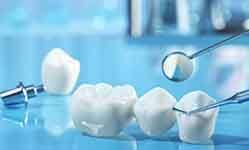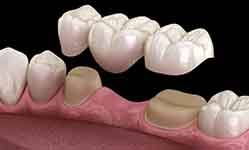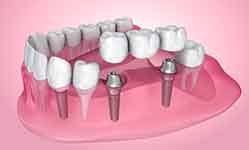Dental Bridges – Greenfield, MA
Bridging Your Smile’s Unsightly Gaps

For a lot of folks, it’s bad enough to lose just one permanent tooth. That situation can cause lasting harm to your looks, oral health, quality of life – the list goes on. You can thus expect that missing several adjacent teeth is an even worse dilemma. Luckily, we at BGH Dental have the ideal solution to this problem: dental bridges in Greenfield! These special prosthetics will “bridge” the large spaces in your smile. To learn more about them, please keep reading or book a visit today.
What is a Dental Bridge?

At its core, a dental bridge is a fixed restoration that can replace one to four teeth. It often consists of dental materials fused to either side of an artificial tooth or “pontic.” Once placed, the device will fill sizable gaps left by tooth loss.
The best candidates for a dental bridge are those who’ve lost a few adjacent teeth. For these patients, a single bridge treatment can potentially restore their whole grins; it’d be very handy and efficient. Aside from that level of tooth loss, it doesn’t take much to qualify for a dental bridge. Most adults can get one if their gums and jaw are healthy.
The Types of Dental Bridges

Before placing your dental bridge, our dentists will give you an oral exam. They’ll then use their findings to draft a custom treatment plan just for you. In particular, our team will likely suggest that you get one of two types of dental bridges. These are:
Traditional Dental Bridge

A traditional dental bridge is the standard kind that’s been around for many decades. In general, it consists of dental crowns fused to the sides of a pontic. It thus relies on your nearby natural teeth or “abutments” to stay in place.
In most cases, a traditional dental bridge is the least costly of the two types. Its materials and features make it less expensive than an implant-based kind. Still, the dentist does have to remove some of your enamel to place it.
Implant Bridge

An implant bridge relies on dental implants – small titanium posts placed in your jaw’s sockets. Once these posts fuse with your jawbone, they secure the final restoration and stop it from moving around. A proper implant bridge won’t loosen or fall like other prosthetics sometimes do.
Due to its implant posts, an implant bridge won’t alter your existing teeth; a dentist doesn’t “prep” abutments to place it. However, this type costs more than the standard option.
The Benefits of Getting a Dental Bridge

By getting a dental bridge, you’ll receive many great benefits. The most common of these are:
- A Gorgeous Grin – A dental bridge’s teeth are made of porcelain, so they blend seamlessly with your whole smile.
- Better Oral Health – Once a dental bridge “bridges” your smile gap, it reduces the spread of harmful bacteria and stops other teeth from tilting.
- Easier Eating – Your dental bridge should help you chew certain foods more easily.
- Lasting Results – Most dental bridges last 5-15 years, and well-maintained ones can reach lifespans of 20 years or more!
By now, you’ve hopefully seen just what a dental bridge can offer your smile. Consider whether this restoration would work for you and book a visit with us.


